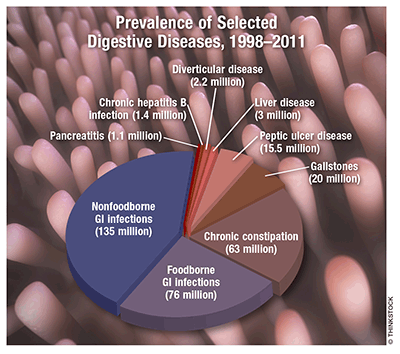US Pharm. 2014;39(12):26.
Digestive diseases were the first-listed diagnosis in 69% of the 104 million ambulatory care visits made in 2004, according to the National Institute of Diabetes and Digestive and Kidney Diseases.

Analysis by Age: More than one-half of ambulatory care visits for gastrointestinal (GI) infections occurred in patients aged <15 years (1,930/100,000), a rate four times higher than in other age groups. Hepatitis B (HepB) visits were higher among those aged 15-44 years (306/100,000) and 45-64 years (392/100,000). Of the 1.5 million visits for peptic ulcer disease (PUD), the rate increased with age: a 78% increase between ages 15-44 years and 45-64 years, and a 116% increase between ages 45-64 years and ≥65 years. Except for patients aged <15 years (3,497/100,000), the number of visits for chronic constipation increased with age: by 42% between ages 15-44 years and 45-64 years, and 193% between ages 45-64 years and ≥65 years. For diverticular disease, visits in patients aged ≥65 years surpassed those in patients aged 45-64 years by 165%. Visits for liver disease were highest at ages 45-64 years (1,944/100,000). Visits for gallstones increased with age, although only modestly for patients ≥65 years. Visits for pancreatitis increased 107% between ages 15-44 years and 45-64 years, but the rate was 22% between ages 45-64 years and ≥65 years.
Analysis by Race: Visits for GI infections were nearly 46% more frequent among white patients than among black patients. The rate of visits attributed to HepB (248/100,000) was four times higher in black patients (510/100,000) than in white patients (98/100,000). There were 32% more visits for PUD (491/100,000) among black patients versus white patients (371/100,000). The rate of visits for chronic constipation was 25% higher among black patients. For diverticular disease, white patients exceeded black patients by 18%, and liver disease was 12% more frequent in black patients. Visit rates for gallstones were 18% higher among white patients. Pancreatitis-related visits were 25% higher among black patients.
Analysis by Gender: Visits for GI infections were 18.1% higher in females than in males. The rate of visits for HepB (248/100,000) was four times higher in males (418/100,000) than in females (83/100,000). There were nearly 41% more visits for PUD in females (574/100,000) versus males (408/100,000). The rate of visits for chronic constipation was 60% greater among females. Forty-five percent more females than males had visits for diverticular disease, and 7% more females than males had visits for liver disease. The rate of gallstone-related visits was 162% higher in females than in males, and that for pancreatitis-related visits was 52% higher among females.
To comment on this article, contact rdavidson@uspharmacist.com.





